RAILWAYS OF BRITAIN - 44
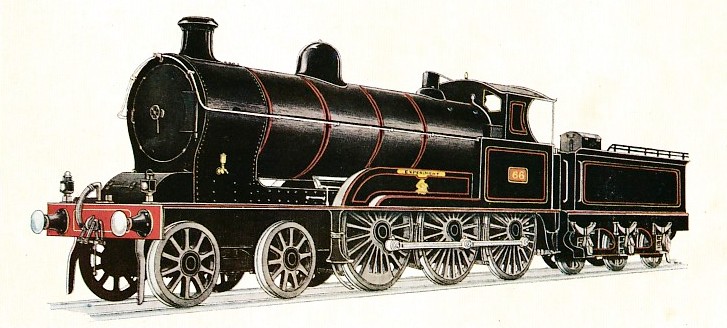
LONDON & NORTH WESTERN RAILWAY EXPRESS PASSENGER LOCOMOTIVE, No. 66, “Experiment” class, designed by Mr George Whale, M.Inst.C.E.
THE North Western has adopted Britannia as its arms, and a more representative British institution it would be difficult to find. By its natural growth from the main stem of the London & Birmingham, and by the gradual absorption of over a hundred other railway companies, it has attained a length of two thousand miles. In a year it carries over 77 million passengers and 55 million tons of minerals and merchandise, and its revenue is £16,000,000, that is £43,600 a day.
The story of the North Western is always taken to begin with the Liverpool & Manchester, as it really does, but its claim to that ancestor is by absorption, and if age is to date from that of an amalgamated company it is entitled to a longer pedigree. Six miles north-east of Merthyr Tydvil is Sirhowy, to which from the Monmouthshire Canal - entering the Usk a short distance above Newport - there ran a tramroad 28 miles long for the carriage of iron and coal, the iron from the Sirhowy and Tredegar works. This was a similar arrangement to that which put Penydaren works - which also belonged to the Homfrays - in communication with the Glamorgan Canal, but it was more recent, the Act not being obtained until 1802; and, as far as Trevill, it was a real railroad laid with edge rails. On it in 1829, the year before the opening of the Liverpool & Manchester, was placed the sixteenth engine built by the Stephensons at the Forth Street works, the Rocket being the nineteenth and the Invicta the twentieth. This was the long-lived Tredegar locomotive which was at work when the North Western took over the line in 1860, and, after working for over fifty years, was withdrawn in 1882. It was a 6-coupled goods engine, originally not unlike the Experiment of 1826 (No. 6 of the Stockton & Darlington), which was the ninth engine built by the Stephensons; but it was more powerful, the cylinders being 10½-in by 20-in, and the coupled wheels 42-in in diameter, while the cylinders of the older engine - which seems to have been the first with 6-coupled wheels - were 9-in by 24-in and the wheels 48-in.
So far as the project was concerned the Liverpool & Manchester was, however, older than the Sirhowy, for in 1797 William Jessop proposed a tramroad for horses between the two places and surveyed a route which was not approved of. In 1798 Benjamin Outram made a survey of another route, merely Jessop’s modified, which met with the same fate, the only result being that the canal people, in fear for their monopoly, became a little more reasonable.
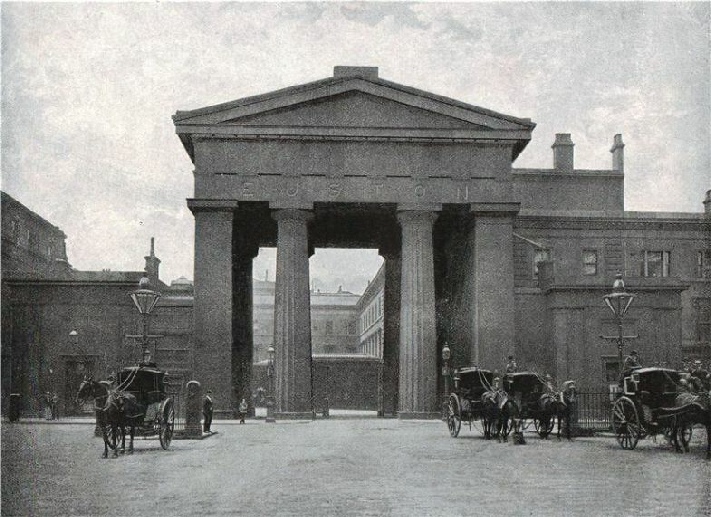
THE ENTRANCE TO EUSTON STATION.
For more than twenty years the canal continued to be the only means of communication, except, of course, the road; and as business increased in the towns so did the canal business increase, until it became too great to be properly dealt with. Evidently something had to be done, and what more natural than that the something should be the making of one of those railroads that people were beginning to talk about?
It was early in 1821 that Joseph Sandars, one of the leading Liverpool merchants, met William James the land-agent, who happened to be in the neighbourhood on a survey. James had laid several short tramroads on private estates in Gloucestershire and elsewhere, and was interested in their introduction. He found a willing listener in Sandars, who had recollections of the Jessop and Outram plans; and the meeting resulted in James being allowed to begin, partly at his own expense, a survey of a suitable route for the information of a committee formed by Sandars. While that survey was in progress, under difficulties reminding one of a scouting expedition through an enemy’s country, James went to Killingworth to look at George Stephenson’s engines, and from that time onward he became an enthusiastic advocate of the locomotive. In fact he became a partner with a fourth share in Stephenson & Losh’s patent, and started “travelling” for the firm, his “line” being what he called “engine-railroads”.
His survey proving too incomplete and sketchy for working purposes, a new survey was made during the next year in which he was assisted by Robert Stephenson, and it was while this was in hand that Chat Moss was first crossed, or rather attempted to be crossed, for James nearly disappeared by sinking into the swamp, and further advance was postponed owing to the want of a firm footing for the theodolite. For this and other reasons the plans were not ready until too late for the next parliamentary session, and there were negotiations and a Public Declaration and a public meeting, and futile attempts at an understanding with the canal company.
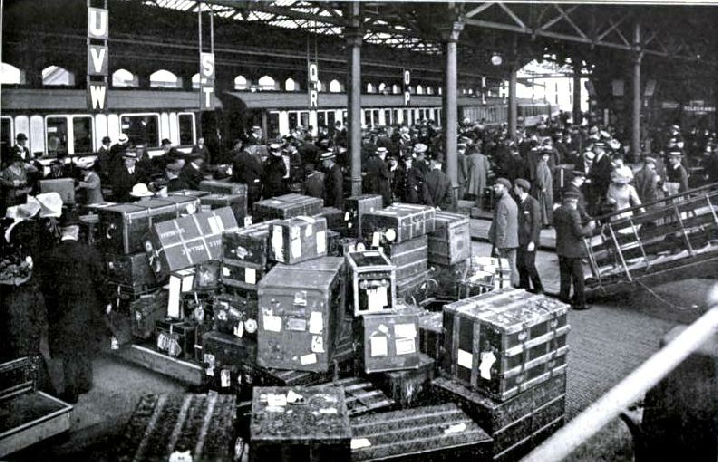
ARRIVAL OF A WHITE STAR LINER AT HOLYHEAD - special train preparing to leave for London.
Then followed the appointment of George Stephenson as engineer, another survey by him and T. O. Blackett, and the issue of the first prospectus on the 29th of October 1824, which laid stress on the probable profit to be made out of the carriage of merchandise, and only cautiously referred to the conveyance of passengers; and in 1825 the first Bill was introduced. It was opposed by the canal company, and every other local vested interest, with a display of ignorance and venom on the part of the counsel for the opponents - Alderson, for instance - that makes one wonder of what sort of men Barons of the Exchequer were made; and it was thrown out in the Commons. Then another survey was undertaken - the sixth - not by George Stephenson, but by the Rennies and Vignoles, who laid out a line avoiding parks and game preserves while the canal company was arranged with; and in 1826 the Act was obtained, “for making and maintaining a Railway or Tramroad from the town of Liverpool to the town of Manchester”.
George Rennie expected to be chief engineer, and felt so sure of the post that he would only accept it on his own conditions, one of which was that he should appoint the resident engineer, which meant that he would get rid of George Stephenson. The directors, quite appreciating the position, appointed Stephenson as chief, and the Rennies had no more to do with the Liverpool & Manchester. Stephenson appointed three residents, all his pupils, Joseph Locke, William Allcard, and John Dixon; and to Dixon was given the Chat Moss section, where he had the difficult job of floating a railroad for the first time over a peat bog - four miles of it, twenty or thirty feet deep, mostly sphagnum living and dead, a mass of plant remains that thickened and thinned with every change of weather. How it was done, with hurdles and tree branches and hedge cuttings and dry turf and trusses of heather, and tar barrels as drain pipes, and gravel as ballast, until every 67 cubic ft. of raw moss became 27 cubic ft. of embankment, every one knows, though every one does not remember that the whole problem was new. There was also Parr Moss to be crossed for a mile and a half by dumping down into it the clay, stone, and shale from a neighbouring cutting, until it sank to the bottom and formed a road that was level with the marsh around. Then there were cuttings to be made - Olive Mount, for instance - and tunnels at the Liverpool end, and bridges, 63 of them, and viaducts, quite trifles nowadays when the North Western has 120 tunnels, over 7000 bridges, and nearly 400 viaducts on it, but then a very different matter, for the Liverpool & Manchester was the great experimental railway.

NO. 513 - “PRECURSOR” TYPE.
In making the road one of Stephenson’s locomotives, the Twin Sisters (with two chimneys), in 1827, and another, the Lancashire Witch, in 1828, began work hauling the wagons of stuff from the two great cuttings to be used in forming the embankments, the first engines of a permanent way department; but, notwithstanding this and the Stockton & Darlington, some of the directors refused to believe that locomotives could deal with the general traffic, and for a time held out in favour of rope traction all the way. Finally, however, the rope with stationary engines was adopted for the Liverpool and Sutton inclines (which had been introduced with the Rennie survey and were admitted to be too steep for any existing locomotive to ascend with a load), and a prize of £500 was offered for the best locomotive to work the rest of the line.
The course was a level stretch on the Manchester side of Rainhill Bridge. It was 1¾ miles in length, of which 220 yards at each end were allowed for starting and stopping. Ten double trips had to be made along the 1½ mile course, representing a journey from Liverpool to Manchester; then water and fuel were to be taken in, as at that terminus, and another series of ten double trips performed to represent the return journey. The minimum speed was to average ten miles an hour; the load to be three times the weight of the engine; the boiler pressure not to exceed 50 lb. per square inch, with two safety valves, one of which to be out of the control of the driver; the height of the engine to be no more than 15 ft. from the rails to the top of the chimney; and the weight in working order not to exceed 6 tons, engines over 4½ tons to have six wheels. A whole day was devoted to the trial of each engine. The judges were J. U. Rastrick, who built the Agenoria, and afterwards made most of the Brighton line; Nicholas Wood, who invented the railway carriage and wrote much about railways; and John Kennedy, the inventor of the jack-frame and many other items in cotton-spinning machinery.
There were four entries, - Robert Stephenson’s Rocket, Braithwaite & Ericsson’s Novelty, Timothy Hackworth’s Sanspareil, and Timothy Burstall’s Perseverance; but Thomas Shaw Brandreth, a director of the company who resigned just before the completion of the line, was allowed to give an exhibition of his Cyclopede, in which the weight of a horse was utilised on a moving platform so that the animal carried itself at a rate of six miles an hour.
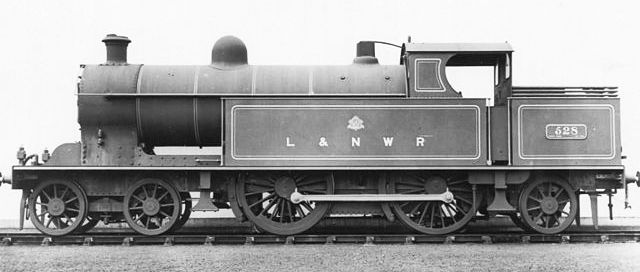
NO. 528 - A POWERFUL TANK ENGINE FOR PASSENGER TRAFFIC.
The Perseverance was a road-motor engine with flanged wheels and a two-speed gear. The boiler had a steam-jacket, and there was a steam-blast, the pipe for the exhaust steam passing through the water-tank, for warming purposes, and returning along the top of the boiler to enter the chimney and deliver the blast at the junction of the barrel. The cylinders were two in number, and were vertical and placed between the driving wheels, the side rods from them not working a crank but toothed wheels, as shown in Burstall’s specification (No. 5405); but he could not get along with the load at more than five miles an hour, and gave up the contest as hopeless.
What is left of the Novelty is at South Kensington. She was invented and built all within seven weeks, and was a tank engine of peculiar construction. Her draught was obtained from a pair of bellows and not from exhaust steam; she just exceeded 16 miles an hour during four trips, and her boiler joints gave way so that she had to be withdrawn. The most interesting thing about her is that she was driven by Charles Fox, one of Ericsson’s pupils, who from the day of her trial became a friend of Robert Stephenson’s and was one of his assistants on the London & Birmingham, being the man who carried out the extension of that line from Camden to Euston. He built the Great Exhibition of 1851, and he, and not Paxton, was the real designer of that building; and he designed and built the Crystal Palace at Sydenham, which is not the same building as that of the exhibition, although the materials of the flat-roofed structure were used up in it.
There were only two engines to be taken seriously in the competition, the Rocket and the Sanspareil, one designed by Robert Stephenson, the other by Hackworth, the locomotive superintendent of the Stockton & Darlington. Both engines are now at South Kensington. The Rocket was built complete at the Forth Street works, where the cylinders of the Sanspareil were also made, the Shildon shops being unequal to the task, just as they were unequal to producing the boiler, which was made by John Birkinshaw, of the rolled rail, at Bedlington. This boiler was a cylindrical shell with one flat end and the other dished, and it had an internal return flue projecting on the fire-grate side and enclosed in a water-jacket; the two cylinders, 7-in by 18-in, were vertical, and worked downwards on the hind wheels, which were coupled to the leaders, the wheels being 54-in; the blast-pipe from the right-hand cylinder was brought across to join with that from the left-hand cylinder and enter the tall chimney half-way from the top, and it was 3-in in diameter; the grate area was 10 sq. ft, the heating surface 90 sq. ft; and the engine weighed in working order 4¾ tons.
This was a quarter of a ton overweight for a 4-wheeler, and there should have been six wheels, but the judges allowed it to be tried and it did very well. On one trip it went at 17½ miles an hour, and it had run 27½ miles at an average speed of nearly 14 miles an hour when it broke down. “The metal forming the partition between the bore of the cylinder and the port-way or steam-pipe along the cylinder side had been cast and bored so thin in one part as to leave less than a sixteenth of an inch of thickness, and the engine had no sooner begun working than the cylinder burst and the race had to be run with one perfect cylinder only, while the fracture of the other one opened at every stroke a direct communication between the boiler and the chimney’’ - that is Hackworth’s story, the usual explanation being that the feed-pump broke. That a faulty cylinder should cause the trouble was not unlikely, for six had been cast before two seemingly perfect ones had been obtained, the fifth having been found defective after leaving Shildon, and the sixth having been fitted at Liverpool.
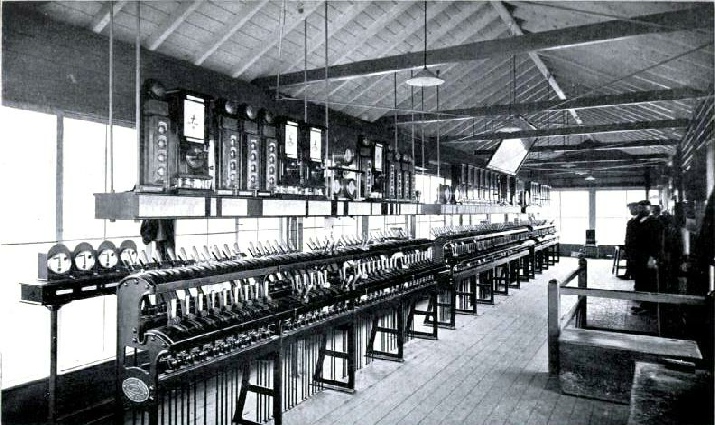
AN UP-TO-DATE SIGNAL CABIN - electric signalling apparatus, South Junction, Crewe.
Thus it came about that the great competition was won by the only survivor, the only engine that complied with all the conditions. On the 8th of October 1829 the Rocket ran the full distance out and home at an average speed of 13·8 miles an hour, the fastest journey being at the rate of 24·1 miles an hour. The boiler was cylindrical, 40-in broad and 72-in long; the cylinders, at an angle of 37 degrees, were - as in the new model at South Kensington - 8-in by 17-in. The firebox, of copper, was not unlike a letterbox in shape, and was bolted on to the end of the barrel; at the top, back, and sides it had a 2½-in water-space, and in front it had a firebrick lining, the gases from it passing through the tubes into a cavity at the base of the chimney which did duty as a smokebox. There were 25 copper tubes 3-in in diameter placed in the lower half of the boiler; the heating surface was 138 sq. ft, and the grate area 6 sq. ft; two 2½-in pipes connected the water-space of the firebox with that of the barrel, and two similar pipes connected the top of the firebox with the steam-space. The working pressure was 50 lb, and, besides the two safety valves, there was a slender mercurial gauge as tall as the chimney, running up the left-hand side of it, indicating steam pressures between 45 lb. and 60 lb. There were two blast-pipes, one from each cylinder, carried along the top of the barrel, entering on each side of the chimney and ending in a blast-nozzle 1½-in in diameter; the driving wheels were of wood, with cast-iron bosses and iron tyres, and their diameter was 56½-in, that of the cast-iron trailers being 34-in; the wheel base was 7 ft. 2-in; the engine weighed 4 tons 5 cwt. in working order, the tender 3 tons 4 cwt, the total weight being 7 tons 9 cwt, but in the trials the weight of the tender was taken as part of the load. On the occasion of the contest the Rocket, according to Vignoles, who was there, was painted yellow lined with black, her chimney being white, while the Novelty was painted a deep blue, but according to the Kensington model she was lagged with wooden battens, and, with her polished oak driving-wheels, black ironwork, and bright copper work, looked as smart as a modern express engine. Her driver was Mark Wakefield. The prize money is said to have been divided between Robert Stephenson, who designed the engine, and Henry Booth, the secretary of the company, who suggested the copper tubes in the boiler and was also the inventor of the coupling-screw.
Needless to say, the Liverpool & Manchester directors talked no more of ropes or horses, and when the line opened on the 15th of September 1830 there were eight engines to take part in the ceremony - on the Northumbrian was George Stephenson, on the Phoenix Robert Stephenson, on the North Star Robert Stephenson (George’s brother), on the Rocket Joseph Locke, who managed to run over Mr. Huskisson, on the Dart Thomas Gooch (George Stephenson’s very excellent secretary), on the Comet William Allcard (resident engineer at the Manchester end), on the Arrow Frederick Swanwick, and on the Meteor Anthony Harding. Four of these engines, the Meteor, Comet, Arrow, and Dart, had cylinders 10-in by 16-in, the three last that were built, the Phoenix, North Star, and Northumbrian, had them 11-in by 16-in. The cylinders were all outside, the first inside cylinder engine being the Planet, which was put on the rail soon after the opening, and on the 4th of December hauled the first goods train from Liverpool to Manchester.
The North Western includes four other railways whose Acts were obtained before that for the Liverpool & Manchester. These are part of the Llanvihangel, a mineral line near Abergavenny, which had its Act in 1811, the year in which there were 180 miles of iron tramroads at work in South Wales; the Nantile, a slate line at Carnarvon, authorised in 1825 and opened in 1828; the Cromford & High Peak, authorised in 1825 and opened in 1830, a line 33 miles long rising 990 ft. from the Cromford Canal and worked by ropes; and the Bolton & Leigh, authorised in 1825 and opened in 1831, on which the Sanspareil worked for fourteen years. In 1829 an Act was obtained for a branch from the Liverpool & Manchester at Newton to Warrington, which was opened in 1833; and in that year, after much opposition, the Act was passed for the Grand Junction Railway from Warrington to Birmingham through Crewe to join the proposed London & Birmingham. Of this line Joseph Locke was the engineer.
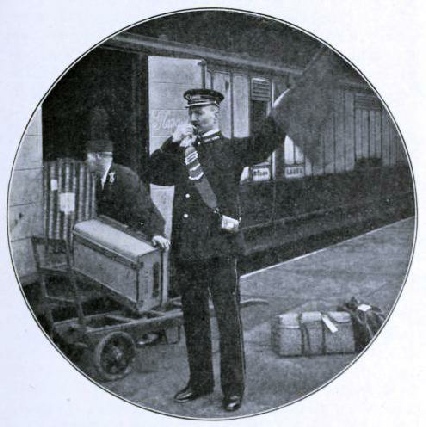
A LONDON AND NORTH WESTERN GUARD.
When George Stephenson was building the Sankey Viaduct he went to Stourton quarry in search of stone, and there met Thomas Brassey to whom it belonged. Brassey was the agent for the large estate on which Birkenhead now stands, and had taken part in the survey of Telford’s famous road from Shrewsbury to Holyhead. He was not a navvy, as some people suppose, but a gentleman of the old school, and the best descended of all the rail way men. His family had lived at Bulkeley Old Hall for six centuries before they moved in 1663 to their other property at Buerton, where Thomas was born in 1805. The Liverpool & Manchester Company were making their own line, as all the other companies had done up to then, the only thing in the nature of a contract being the usual piece-work in a small way; and the idea had occurred to Stephenson that as a chief engineer had quite enough to do without supervising all these numerous details there was an opening in railway making for a new trade, that of contracting on a large scale for sections of the line by responsible men of sufficient means. In talking to Brassey he thought he had found the very man for such a task, as indeed he had, and so he opened his mind to him and enlarged on the possibilities of such a career.
Joseph Locke agreed with his chief that the piece-work business was unsuitable for such large ventures, and when planning the Grand Junction he cut the line up into sections and introduced the tender system. Old George went to see Brassey, and suggested that he should put in a tender for some of the works and get his bankers at Chester to finance him. The bankers at once appreciated the idea, and Brassey sent in his first tender, that for the Dutton Viaduct, which was too high, and then his second, for the Penkridge Viaduct, which was accepted. This brought him into contact with Locke, and henceforth the two were inseparable. Wherever Locke was engineer and Brassey was contractor the work was thoroughly well done and finished to the minute - and there were no extras. Brassey was the navvy king; he kept his engagements, he made money, and he was idolised by every one he employed - and sometimes he had 80,000 men under him, for the railways he made extended for 6667 miles, including the ten with which he began on the Grand Junction.
The Grand Junction was for a time our most important railway. Within a few years it had absorbed the Warrington & Newton, the Liverpool & Manchester, the Bolton & Leigh, the Crewe & Chester, and the North Union from Newton to Preston, and it had made arrangements with the Lancaster & Preston and the Lancaster & Carlisle when in 1846 it and the Manchester & Birmingham, which had only got as far south as Crewe, were amalgamated with the London & Birmingham to become the North Western, with a through route from London to Carlisle.
The London & Birmingham, like the Grand Junction, obtained its Act in 1833. The opposition was so great and virulent - there were 112 miles to be fought over - that the Bill failed to pass at the first attempt, being thrown out by the House of Lords, but during the winter of 1832 the country opponents were “conciliated”, as it was called, that is to say half a million of money was shared amongst them to be debited to the company’s capital account, and the towns were silenced by keeping the line at a distance from them so that their inhabitants might have a long, healthy walk to the nearest station.
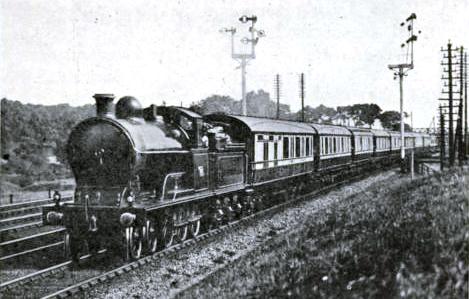
THE SCOTCH EXPRESS travelling at high speed.
The Rennies, as in so many cases, had already planned a route, and the promoters had at first thought of employing them and George Stephenson as joint engineers; but to this the Stephensons would not agree, and again the decision was against the Londoners. But the Rennies went on with their scheme, and there were two projects before Parliament, the earlier of which was rejected. The line as made was surveyed by Robert Stephenson, who walked the distance no less than twenty times. It was made by contract, and very few of the contractors profited by it. The works were on a much larger scale than those of the Liverpool & Manchester, and included the three great cuttings at Tring, Denbigh Hall, and Blisworth, and the eight tunnels, of which Primrose Hill and Kilsby gave immense trouble.
At Primrose Hill the pressure of the clay swollen by the moisture of the atmosphere squeezed the mortar through from the joints and made the face of the brickwork fly off in chips, until the hardest bricks obtainable were laid in Roman cement, which by setting before the pressure became great enough to force the bricks into contact formed a sound arch 27-in thick. At Kilsby the trial borings missed a water-laden pocket of sand and gravel in the lias shale, and the second shaft put down struck into it. Steam pumps had to be installed, and by pumping for eight months continuously at 1800 gallons a minute, clearing out as much water as the Thames holds at high tide between London Bridge and Woolwich, the 1300 men at work night and day managed to proceed with the tunnel, in which 13,000,000 bricks were used, the cost being £300,000 instead of the contract price of £99,000.
By the 4th of June 1838 the line had been opened from London to Denbigh Hall, the name of one of the coaching inns, and from Rugby to Birmingham, the gap of 35 miles being worked by coaches; on the 17th of the following September it was opened throughout under its first manager, Ashlin Baxter, whose first clerk was David Stevenson, and before many months had elapsed Denbigh Hall had become Bletchley. The line ascended 308 ft, the gradients changing forty-four times, 54 miles of it being uphill and 44 downhill, only 14 miles being level. There was a gradient of about 1 in 70 from Chalk Farm (Camden) down to Euston, and when the line was completed this was worked by a rope and stationary engines. Coming up out of Euston a man stood on the front of the train with a thin short rope, called a messenger, with which he took a hitch round the moving cable and a double turn round the coupling hook, and as he passed Camden he let go. It was for signalling on this rope-line between Camden and Euston that the electric telegraph of Cooke and Wheatstone was first used on the 25th July 1837, but not adopted, as the plan of a whistle worked by an air-tight pipe leading into a tub of water at each end, the mouth of the pipe being above the water level and covered by a bell-shaped receiver dipping in the water, was found to answer satisfactorily. The Doric arch at Euston Grove - as the station was first named - was designed by Philip Hardwick, and finished in 1839. It is built of Bramley Fall stone, and is 72 ft. high, and it cost £35,000, which many thought was a waste of money, particularly after the two hotels were connected by the buildings over the roadway. The first Birmingham station was at Curzon Street, and it was almost as classical as Euston in external appearance.
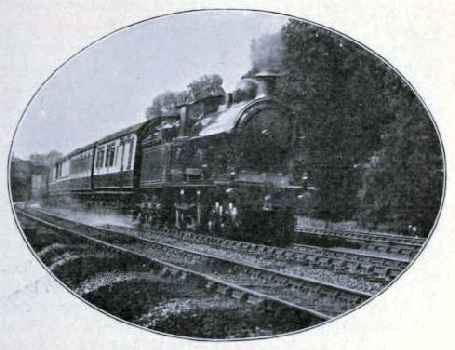
PICKING UP WATER IN SPEED, near Pinner.
The year the London & Birmingham was opened George Stephenson made the first survey for the line from Chester to Holyhead, but little was done for four or five years, and the Act was not obtained until 1844. The engineer was Robert Stephenson, and he it was who built the bridge over the Menai Straits, the greatest engineering achievement up to then. Here was a strait 365 yards across, with the tide rising 20 ft. in it, and the Britannia rock in the middle which afterwards gave its name to the bridge. The intention was to have two cast-iron arches of 350-ft span, but the Admiralty objected, and insisted that the navigation must not be interfered with for a single day, and that not even a scaffold could be allowed while the bridge was under construction.
While the puzzle was being thought over, it happened that the Prince of Wales, an iron steamer, built at Blackwall, instead of entering the water at her launch was hung up on her bilge between the water and the wharf, and lay there, 110 ft. long, uninjured in her construction. This gave the engineer the idea that he could run the line through a hollow girder if the girder were strong enough to support itself. William Fairbairn, who, when an apprentice, had minded the engine at Willington while George Stephenson was earning a little extra by heaving ballast out of ships’ holds, and had assisted in the building of Birkinshaw’s Bedlington ironworks near Morpeth, was consulted. He made a series of experimental models to discover the best form of the tubular beam, beginning with cylinders and ending with a rectangle having hollow cells in the top to strengthen it.
The tubes were built on wooden stages just at high-water mark on the Carnarvonshire side, and floated into their places at the foot of the piers. Their position was determined by a 12-in rope to be paid out to a fixed mark from the Llanfair capstan - the Llanfair of so many supernumerary syllables - “the coils of the rope unfortunately overrode each other upon this capstan, so that it could not be paid out. In resisting the motion of the tube, the capstan was bodily dragged out of the platform by the action of the pawls, and the tube was in imminent danger of being carried away by the stream as the pontoons crashed against the rocks. The men at the capstan were all knocked down, and some of them thrown into the water, though they made every exertion to arrest the motion of the capstan-bars. In this dilemma Mr. Rolfe, who had charge of the capstan, with great presence of mind called the visitors on shore to his assistance; and handing out the spare coil of the 12-in line into the field at the back of the capstan, it was carried with great rapidity up the field, and a crowd of people, men, women, and children, holding on to this huge cable, arrested the progress of the tube, which was at length brought safely against the buttress and veered round”. The tubes were placed with their ends in grooves in the masonry, and lifted inch by inch by hydraulic power, the grooves being filled in with masonry as they rose, so that at every stop they had something to rest on. The Bramah press cylinders held 81½ gallons each, the pressure was equal to a head of nearly
5½ miles, the greatest weight lifted was 1144 tons, and once the weight was so great that the bottom of one of the presses was burst out with it.
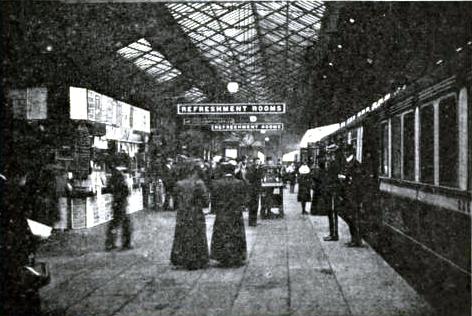
THE 12.5 P.M. LIVERPOOL TO EUSTON EXPRESS, AT CREWE
Really it is a handsomer bridge than Telford’s crossing the strait close by. The same cannot be said of Stephenson’s tubular bridge at Conway, which runs alongside a Telford suspension bridge built in the same manner, so as to look like a long drawbridge from the castle instead of carrying the Holyhead coach road, as does the other suspension bridge across the Menai Straits.
It was to join up with the Chester & Holyhead and the Manchester & Birmingham that the amalgamation took place in 1846, the Grand Junction controlling the links between Birmingham and Chester, and Stafford and Crewe, where they had placed their locomotive works in 1842, the founder being Francis Trevithick, the son of the locomotive’s inventor. He was absorbed with the works by the North Western, and was locomotive superintendent of the northern division until 1857, the southern division having its headquarters at Wolverton, which has been devoted to carriages only since the concentration of the engine work at Crewe in 1862 under Trevithick’s successor. John Ramsbottom, who had been locomotive superintendent of the Manchester & Birmingham.
To Ramsbottom we owe the invention of the water-troughs placed between the lines to enable an engine to pick up its water supply as it travels. They were first put down on the North Western in 1860 - iron troughs, nowadays about 500 yards long, 17-in wide, and 6-in deep, with the water in them kept at a height of 4-in by automatic valves. Seventy yards from each end the bottom slopes upwards till it is level with the upper edge of the sides, the gradient of the line following the slope, so that the bottom of the trough is all along, whether in or out of water, the same distance below the level of the rail. From the tank of the tender rises a rectangular pipe which curves over and passes out through the bottom for about 18-in, and ends in a movable scoop which can be let down when required. As the trough is passed over at a speed of 22 miles an hour or more the water is picked up to the amount of 400 gallons during the quarter-mile. These troughs, which rendered long distance running easier by keeping the size of the tenders within reasonable limits, are now in use on most of our main lines.
When the railway came to it, Crewe had thirty inhabitants; it now has more than as many thousands. When the buildings were put up in 1843 the site of the works occupied two acres and a half; they now extend over 137 acres, of which 48 acres are covered with buildings. The Grand Junction had 75 engines; the North Western has 3000 engines, and in a year they run 50,000,000 miles, that is more than two thousand times the distance round the globe. Crewe began with about 100 men; it now employs over 8000, to which may be added 700 drivers, firemen, and others in the steam sheds; and in comparing it with the works of other companies it should be borne in mind that the carriage works are at Wolverton and the wagon works at Earlestown, giving employment to 5500 more. The reason of its magnitude is that it produces every part of a locomotive except the brass tubes, copper plates, and firebricks, from the raw material. It even makes bricks and tiles and drain-pipes in a Hoffman’s circular kiln, and in its mortar-mills it makes the mortar with which, and the bricks, the North Western builds its engine-sheds and such-like. In fact it seems to attend to all the machinery except the 8000 clocks and watches that the company endeavours to keep accurate.
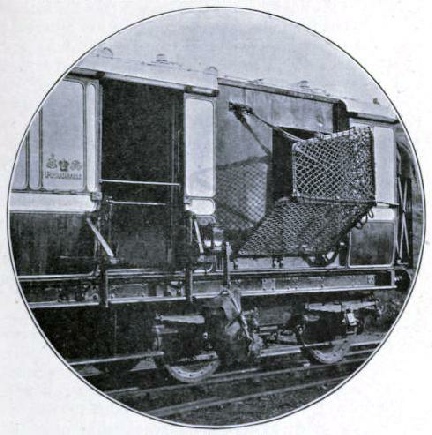
THE TRAVELLING POST OFFICE
Gear in position for picking up and dropping Mails.
Strolling among the miscellanies you find men making iron fencing, artificial limbs, buckets, pumps and cranes, lamps, harness-chains and ship cables; and among other unexpected things is a steam laundry, to which come the dirty engine-cloths from all parts of the system, the grease from them being made into soap at the still more unexpected soap-works a few yards off. In the timber department there is some of the most ingenious machinery in existence, all driven from below, with endless travellers under the floors clearing off continuously the sawdust, chips, and shavings to be used up in the furnaces, so that there is no inflammable rubbish and no waste.
In and out along the mile and a half of workshops runs an 18-in railway, 5 miles long, which began with the pigmy engines built to tow barges on the Shropshire Canal; and of course there is plenty of the ordinary track, the rails of which were made at the steel works, for the North Western rolls most of its own rails. Bessemer steel is no longer used, and though the Siemens-Martin process is not so picturesque it is quite as interesting, particularly when the lumps of ore are scattered in to skip about on the shimmering sea; and the steel-making plant consists of ten of these melting furnaces, capable of a total output of 70,000 tons a year.
It is when the cast steel ingot, 40-in long and 14-in square, emerges from the reverberatory furnace, glowing in all the fire colours, that matters become definite, though it seems an unlikely lump to make a railway rail of. Into the cogging-mill it is run, a massive mangle with rollers more than a yard in diameter, and five huge grooves in them of different sizes. Through the largest it passes, then through the smaller in succession, until it leaves the fifth as a lump of about 8 ft. long with a section 10-in by 8-in. Instantly it is whipped off to the rolling-mill, and through it thirteen times it goes, ringing and clanging at a higher note each time it falls a longer and thinner bar, the thirteenth delivery leaving it over 60 ft. long. Then a saw shrieks through its ends to trim them, and it is straightened and drilled, and becomes a finished regulation rail 60 ft. long, weighing 95 lb. to the yard.
For the improvement of artillery Henry Bessemer invented a revolving projectile requiring so heavy a charge of powder that no gun could stand the strain. To make the gun that would not wear out in a week he set to work to improve the metal until he invented the converter, and by it revolutionised the steel trade. The steel for the purposes of war came into use for the purposes of peace. For one thing it was excellent, namely railway rails, the making of which the North Western was the first to enter upon. The first steel rail was laid under Chalk Farm bridge on the 9th of May 1862; millions of wheels passed over it, and the adjoining iron rails were replaced seven times before it was taken up without being turned.
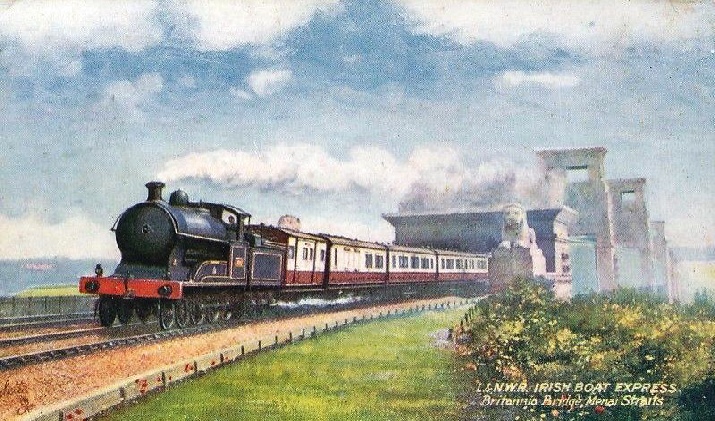
THE IRISH BOAT EXPRESS passing out of the Britannia Tubular Bridge.
The steel rail made it possible to double the weight carried on the wheel, and with its introduction came the increase in the weight of the train and the size of the engine, whose hauling power increases with every increase of weight on its driving wheels. Comparing the present rails with those of the Liverpool & Manchester, and others at South Kensington, the steps in the search for strength and endurance are clearly shown - the fish-bellied rail; the single-headed girder rail; the parallel rail with the small lower flange; the Vignoles rail with a flat foot; the bridge rails of Brunel; the double-headed rail of Locke, intended to be turned when one side was worn out, and abandoned owing to the indentations received in the chairs; and finally the bull-headed rail in which the top alone is used for running on, the lower flange being the means of attachment.
A railroad is not so simple as it looks. In the case of the North Western the formation level for the double track is 30 ft. across; it is gently arched in the middle and sloped off at its edges for drainage purposes; on it is placed a layer of stone pitching extending to within a couple of feet of the slopes, and over that comes the stone ballast, mostly of slag; in this are embedded the sleepers of creosoted Baltic pine, 5-in thick, each sleeper weighing 153 lb, and there are 24 of them to each pair of 60-ft. rails; on the sleepers rest the chairs with a pad of hair-felt between the metal and the wood, the jaw of each chair having four grooves in its inner surface to allow the compressed oak key to expand and keep tight. Joining the rails are the fishplates 18 in. long, bolted in position by four bolts, the plates not being flat but slightly curved so that their edges take a bearing against the upper and lower flanges of the rail and there is a space between the inner side of the plate and the flat of the rail. In fact from the formation level to the top of the rail the road is 30-in deep, and in every mile of double track there are 500 tons of steel, to say nothing of the wood and stone.
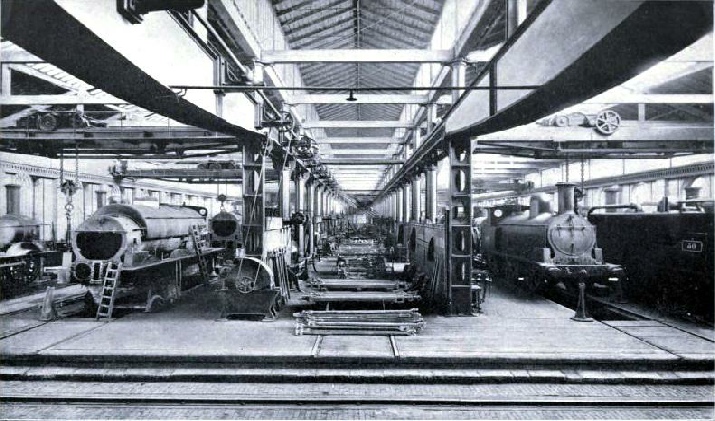
CREWE WORKS - NO. 5 ERECTING SHOP.
The road has to be substantial to carry the rolling weight of the monster engines now put upon it. At Crewe you look upon these from the rail level and fully appreciate their dimensions. Here they come for overhaul; goods engines in one place, passenger engines in another, long rows of them, whose names and numbers, if nothing else, so many schoolboys know; and you can almost tell their age by the height of their shoulders.
The locomotive boiler has become so large of late that the roof of the boiler shop has had to be raised, and a mighty thing a boiler looks as it is slung vertically for the hydraulic gap riveter to get at it. The shop is big enough, over 100 ft. across and more than a furlong in length, to build 200 boilers at a time and deal with 3000 in a year; and here, amid the needful machinery, is a crowd of them in all stages, including the stage in which they are tested by steam, then by hydraulic, and then by steam to more than their working pressure. Adjoining this boiler shop is the flanging shop with its hydraulic presses, one of which can give a squeeze of 650 tons; to them, from the gas furnaces near by, come the steel firebox plates glowing hot, with the air in a tremor above them, to be flanged at one operation, slowly, gently, irresistibly, with about as much trouble as so many tea-trays.
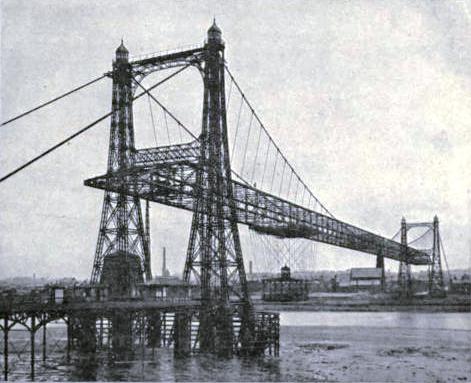
TRANSPORTER BRIDGE ACROSS THE MANCHESTER SHIP CANAL
Contrasting with the boiler shop is the quiet, picturesque foundry where, amid the haze that fills the ample area, the moulders handle and finger the sand as deftly as a potter does the clay, and the dazzling molten metal runs from the furnaces and pours from the ladles with little spurts of flame. There is one foundry in which rail chairs are cast and nothing else, just as among the timber there is a key department where the oak is cut up into keys by the sawing machine that delivers them automatically into tanks that hold 30,000 at a time, to be steamed and passed on into moving cylinders that dust them with blacklead and pass them on to be compressed in steel dies and thence loaded through a pipe into the wagon that takes them to the stores.
But these are small things compared with the steel foundry where the three melting furnaces produce forty tons of castings - wheels, motion-plates, horn-blocks, and sundries - a week; or the steel forge with its presses and hammers, its punching and shearing machines, its 7-ft saws that screech through a 9-in axle in some five-and-twenty seconds as their jagged edges whirl at 13,000 ft. a minute, its plate and axle mill, its spring mill and tyre mill. Tyre-making looks quite easy; the pressing of the conical ingot into a thick disk, the pressing of the hole in the disk and the pushing out of the centre-piece, the pair of rings reheated and pressed into one which in two operations in the vertical rolls becomes a finished tyre.
Busiest of all is the fitting shop, where everything is finished to templates and standard gauges so as to be interchangeable - and there are more than 2000 parts in a standard engine; and most interesting, because most comprehensible, are the erecting shops where the engines are put together, and you see them rising from their foundations to their chimneys like a row of new cottages.
An engine begins with the placing of the two frames on the balks; here is one in which the temporary crossbars have been added to keep the frames parallel while the cylinders are slung into position, and we see them being bolted in. The motion-plate, otherwise the spectacle-plate, will come next to act as the first permanent stay between the frames and serve other purposes as well. Then come the stay-plate and the foot-plate to complete the main framework. Into the square-headed notches, on the under surfaces of the frames, the guides for the axle-boxes - the horn-blocks - will be bolted and the foundation will be ready for checking by almost every variety of measurement, lengthways, crossways, diagonally, for distance and direction, the main object being to ensure that the centre lines of the cylinders are parallel to the frames, and not the fraction of a second out of a right angle with the horn-blocks.
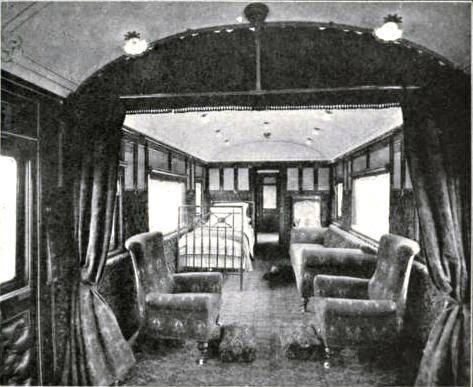
AN INVALID CAR. Passengers can be taken to any station in the country without disturbance
Here is another, duly examined and found correct, which is being finally fixed together. On it will come the angle-plates for the side-plates to be riveted to, all the rivet holes being driven by an electric drilling machine, and the slings or supports for the springs will be put on. Under another engine men are fitting into the horn-blocks the axle-boxes, which will have to have their bearing surfaces bedded on the wheel journals before they are done with.
Next comes drifting through the shed the boiler which no one sees in public, for it will have to be lagged with felt and coated with the lagging-plates of steel and their numerous layers of paint. As it hangs in mid-air it threatens to crush any foundation it may rest upon, but down it is eased, fairly and squarely, the firebox slipping in just in front of the foot-plate, and the smokebox-plate entering between the cylinders. At the rear end it rests on the expansion-brackets riveted to the frames, and on them it will slide as it lengthens with heat, for it will be half an inch longer in steam than when it is cold, and hence the only place in which a boiler is rigidly fixed is at the smokebox tube-plate.
In another engine the boiler is in place and the smokebox is being fastened to the frames. In it is the blast-pipe, which has to be as exact in position as the cylinders and horn-blocks, for through it passes the exhaust steam to cause the vacuum that makes the draught on which the fire depends, and if it is not central with the chimney there will be trouble; as there will be if the door of the smokebox that seems to fit no closer than the lid of a kettle is not airtight.
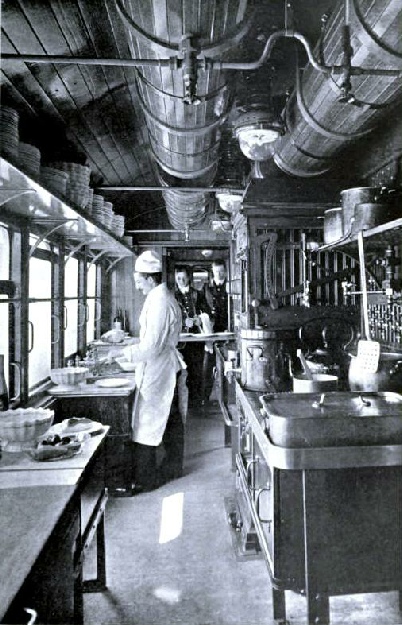 Meanwhile the machinery is being put together below. The pistons and their rods are being set in the cylinders with their rings and packing. The crossheads have to go on, and the slide-bars and valve gear, and - well, and the rest, for we are going into too much detail for our space - and the cab has to be built on the foot-plate, and the chimney, not much higher than a man’s hat nowadays, has to be placed on the smokebox.
Meanwhile the machinery is being put together below. The pistons and their rods are being set in the cylinders with their rings and packing. The crossheads have to go on, and the slide-bars and valve gear, and - well, and the rest, for we are going into too much detail for our space - and the cab has to be built on the foot-plate, and the chimney, not much higher than a man’s hat nowadays, has to be placed on the smokebox.
IN THE KITCHEN CAR OF THE AMERICAN SPECIAL.
Then the chains are passed under the engine for a heavy lift; they are hitched on to the cranes, and up in the air it moves for the wheels to be run under it. Judging the distance, the men at each wheel stand ready to catch it without a jar as it comes down and fits as it was built to do. The linking and joining and putting in of a myriad things will follow, until completion comes with the buffer-plank and couplings. And then a couple of cranes pick it up as if it were a baby and put it on the central track, where it has its first little run - to the weighing machine.
When the London & Birmingham began it jobbed its engines from Bury’s, but that did not last long, and since then it has built at Crewe some 5000 engines of its own. The first thousand was completed in 1866 under Mr. Ramsbottom, the second in 1876, the third in 1887, and the fourth in 1900 were all constructed under Mr. F. W. Webb, who retired in 1903, to be succeeded by his assistant Mr. George Whale, who has recently been succeeded by Mr. C. J. Bowen Cooke. One thing is remarkable, and that is that not until the Black Prince in 1897 did the North Western build an engine with a bogie, the bogie differing from all others in not having a centre-pin.
Mr. Trevithick built a large number of excellent outside cylinder engines, among .them being the famous Cornwall, which had 8 ft. 6-in driving wheels and is said to have travelled down Madeley bank at 117 miles an hour. As built in 1847 this engine was a 4-2-2 with the boiler below the driving axle, the idea being to give her the lowest possible centre of gravity; her cylinders were 17½-in by 24-in; her heating surface was 1046 sq. ft; the excentric was on the outside of the driving wheels and larger in diameter than the throw of the crank; and the regulator was on the top of the boiler. As thus built she was somewhat of a failure, and she was rebuilt by Mr. Ramsbottom as a 2-2-2 in 1858, with her boiler above the driving axle in the usual way. She was known for long as one of the fastest of engines; and for thirteen years she worked the expresses between Liverpool and Manchester, running altogether about a million miles before becoming obsolete.
In 1862 Mr. Ramsbottom put on the road the Lady of the Lake, one of the Problem class of high-speed engines. She was a 2-2-2 with 7 ft. 7½-in driving wheels, 3 ft. 7½-in leaders and trailers, cylinders 16-in by 24-in, heating surface 1000 sq. ft, and she weighed 27 tons. In 1876 the Lady of the Lake was rebuilt by Mr. Webb, and made another start with 7 ft. 9-in driving wheels, 3 ft. 9-in drivers and trailers, cylinders as before, heating surface 1047 sq. ft, her weight being 29 tons 6 cwt.
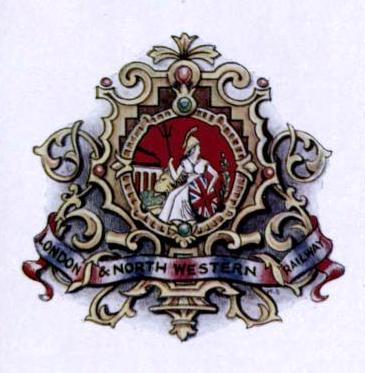
LONDON & NORTH WESTERN RAILWAY COAT OF ARMS.
Another famous class introduced by Mr. Ramsbottom was that to which the Newton belonged, built in 1866. These were 2-4-0’s with 6 ft. 9-in coupled wheels and 3 ft. 9-in leaders, cylinders 17-in by 24-in, heating surface 1068 sq. ft, and a weight of 29 tons 14 cwt. In 1874 Mr. Webb built the Charles Dickens, household words among railwaymen; she had 6 ft. 9-in coupled wheels and 3 ft. 9-in leaders, being also a 2-4-0, and she also had 17-in by 24-in cylinders, but her heating surface was 1063 sq. ft, and her weight 32 tons 15 cwt; another difference being that while Mr. Ramsbottom worked at 120-lb. pressure, Mr. Webb used 150 lb.
This engine continued to run her daily trip between Manchester and London until the 2,000,000 miles were completed, and then she retired with a world’s record. Another of this Precedent class was the Hardwicke, which in 1895 made the record run from Crewe to Carlisle, 141 miles, at the average speed of 67·2 miles an hour.
Having made excellent simples, Mr. Webb turned his attention to compounds, of which in sixteen years he built a hundred of the 3-cylinder type. First came the Experiments, of which 30 were built, then the 40 Dreadnoughts, then the Teutonics, the 8-wheeled Greater Britains and the 8-wheelers of the John Hick class, of which there were 10 each. The Experiment was not quite an experiment, for the experimental engine was one of Trevithick’s old singles with 15-in cylinders, one of which Mr. Webb reduced to 9-in by lining it. This engine he set to work on the Ashby and Nuneaton branch in 1878, and the experience thereby gained led him to build his first Compound with the two equal high-pressure outside cylinders working the rear drivers and the low-pressure cylinder between the frames working the front drivers. In her the high-pressure cylinders were 11½-in by 24-in and the low-pressure cylinder 26-in by 24-in, but in the Compound and those that followed the high-pressures were 13-in; in all the driving wheels were 6 ft. 9-in and the heating surface 1083.
In the Dreadnoughts, which began in 1884, the driving wheels were 6 ft. 3-in, the cylinders were 14-in by 24-in and 30-in by 24-in, the heating surface was 1400, and they were 4¾ tons heavier, the weight being 42½ tons. The Teutonics, which first appeared in March 1889, had driving wheels 10-in larger and leading wheels 4½-in larger, 4 ft. 1½-in instead of 3 ft. 9-in, the weight being 3 tons more. The Jeanie Deans belonged to this class - the only one whose name did not end in ic - as also did the Ionic, which in 1905 ran the 299 miles from Euston to Carlisle without a stop.
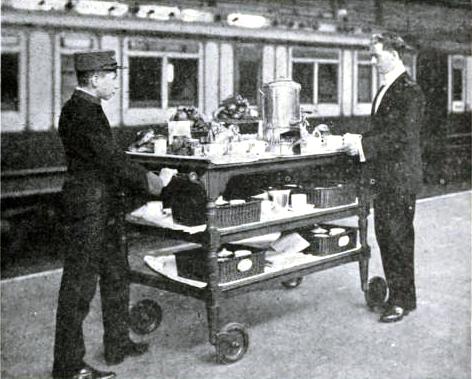
A Tea Wagon at Euston.
The Greater Britain, turned out in 1891, had similar wheels, with a pair of trailers of the same size as the leaders, and the high-pressure cylinders were 15-in instead of 14-in, and the heating surface was 1541 instead of 1400, the weight being increased to 52 tons 2 cwt. In the middle of the boiler was a combustion-chamber into which led copper tubes from the firebox and out of which led 156 brass tubes into the smokebox. It was one of this class, the Queen Empress, that went to the Chicago Exhibition in 1893, and travelled 1500 miles on American railroads under her own steam. The other 8-wheelers had 6-ft. driving wheels. Like all the 3-cylinder compounds they went to Crewe to return no more, all of them condemned to be broken up.
In 1897 Mr. Webb produced the Black Prince, a 4-cylinder compound with two high-pressure cylinders of 15-in and two low-pressure cylinders of 19½-in. This was an 8-wheeler, but instead of trailing wheels there was a leading bogie, the drivers being 7 ft. 1-in and the bogie wheels 3 ft. 9-in. There were two blast-pipes and two chimneys in one flat casing, the smokebox being divided so that half the tubes discharged into one part and half into the other. With low-pressure cylinders of 20½-in there were 39 similar engines forming the Diamond Jubilee class; and 40 more 4-cylinder compounds followed of the Alfred the Great type, which were practically the same with larger boilers. These were the last compounds built at Crewe, Mr. Whale being in favour of the simple life, but he took the Alfreds in hand and greatly improved them by giving them a separate motion for the high-pressure engine, which as originally constructed worked off the motion of the low-pressure one.
Mr. Webb’s Precursor of 1874 was a 2-4-0, Mr. Whale’s Precursor of 1904 was a 4-4-0; and she was the first North Western engine with a steel-framed tender, for up till then all the Crewe tenders, even those of the express compounds, were timber-framed and as designed by Trevithick. She was the first of a large class having cylinders 19-in by 26-in, heating surface 2009, driving wheels 6 ft. 9-in, bogie wheels 3 ft. 9-in, and a weight of 59¾ tons. These powerful engines did away with the double-heading that had become characteristic of the company’s heavy trains, but even they were unequal to mounting alone that long six-mile climb at 1 in 75 from Tebay to Shap summit. To be good enough for that, Mr. Whale introduced in 1905 the second Experiment, a 4-6-0, with 19-in by 26-in cylinders, coupled wheels 6 ft. 3-in, bogies 3 ft. 9-in, heating surface 2041, working pressure, as that of the Precursors, 175, weight of engine 65¾ tons, weight of tender 37 tons. These two classes are now doing the main express work of the line, taking along the 350-ton trains as easily as the heavy 74¾-ton 10-wheel tanks are handling the shorter distance traffic; and, including all station stops and incidental slows, they are averaging over 55 miles an hour.
As the engines have improved so have the carriages even of the highest class. The North Western built a carriage for Queen Adelaide as far back as 1842 which is still preserved at Wolverton, as is also the saloon carriage which was made for Queen Victoria in 1905 by joining together the two separate saloons built in 1869 and mounting them on one under-frame. In 1902 the present royal train was built at the company’s expense as the others were, and as all are in this country, the train being the company’s property and kept for the use of the royal party - who pay their fares like other passengers, including the extra mileage charge for the special. This is a train so designed that the passengers are expected to forget that they are in a train, so smooth and silent is its movement, so tastefully is it furnished and decorated. With their silver-mounted bedsteads and easy-chairs and window draperies there is nothing except the roof to show that the apartments are sections of a railway carriage.
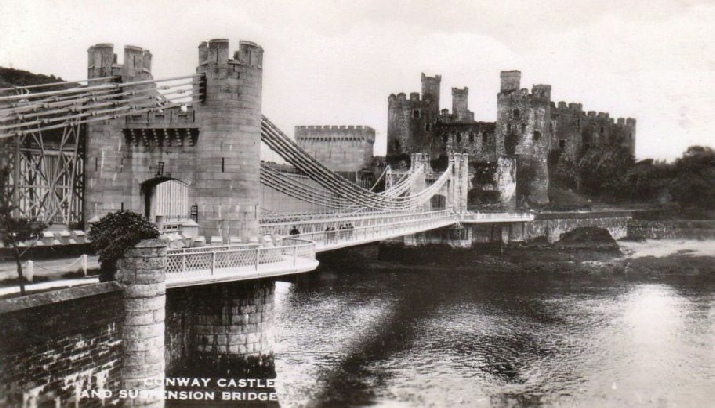
CONWAY CASTLE AND SUSPENSION BRIDGE. The railway bridge is on the left and the trains run through the square tower.
When the royal train is on its journey the most elaborate precautions are taken to ensure its safety. No ordinary signalling will do, and yet what a lot of it there is! Along the 158 miles between London and Crewe there are 160 signalmen in 132 signal-boxes, and for each non-stop train these men have to lower 300 signals to “line clear” and pull over 360 levers; the train travels over 180 pairs of points, and passes 80 signals at danger at branches and junctions to keep the main line safe; and some 1450 messages about it are exchanged by telephone and the block instruments between the signalmen.
In 1864, Queen Victoria wrote her letter to the railway companies expressing the hope that the same security should be ensured for all her people as was so carefully provided for herself - a well-intentioned hope impossible to be realised, for it meant, and would mean, that no train could follow another train on any line at a less interval than half an hour, and that the railway should be practically closed all day long except at the terminal stations. When the Queen travelled, a pilot engine was run a quarter of an hour in front of her throughout the journey, and no train or vehicle except this pilot was allowed to proceed upon or cross the line during at least half an hour before the time at which the royal train was booked to pass. All shunting work was stopped on the adjoining lines during the same period, and no engine or train could leave a station or siding upon the same line for fifteen minutes after she had gone by.
In addition to this no light engine or train, except a mail or postal train, could run between any two signal-boxes between the passing of the pilot and the passing of the Queen. All the facing points were bolted to prevent the royal train getting on the wrong line; all the level-crossing gates where there were no gate-keepers were locked an hour before the train was due; every station and crossing was guarded to keep trespassers off the line; all along the line platelayers with flags by day and lamps by night were on the watch to keep the road clear; the train was accompanied by a staff of workmen who watched each side of it so as to notice any irregularity in the running of the carriages; and it was telegraphed from point to point, and carried an instrument by which it could telegraph at any time on the journey. And similar precautions are taken with the royal train now. Everything has to give place to it except the breakdown train, but then the breakdown is on its message of life or death and travels at speeds that are not recorded lest the timid should avoid the route.
One royal journey, however, is on the list very different to all this, and may have led to it. It occurred when Frank Trevithick was locomotive superintendent at Crewe. The story is too strange to be told except at first hand, and in his own words, therefore, this is how he drove the Queen.
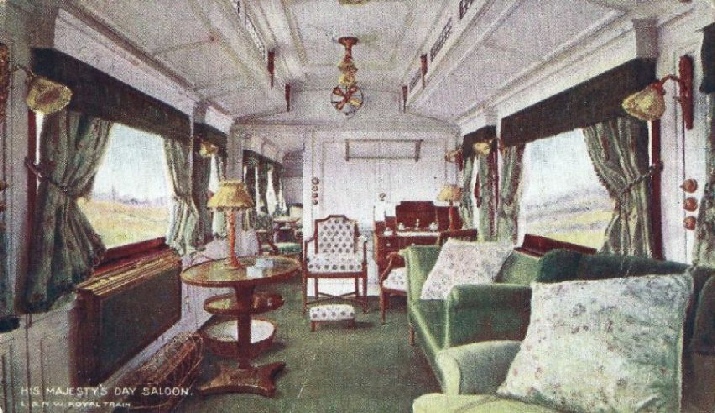
INSIDE THE KING’S CARRIAGE - the Day Saloon.
“About the year 1846, on a rainy, blowing, autumnal Saturday night, the writer was summoned, from nursing an influenza cold, to the railway station. Her Majesty, Prince Albert, and the rest of the Royal Family, had unexpectedly arrived and desired to be in London by ten the following morning. Continued rain had caused the line to be unsafe in places, except at comparatively slow speeds. Saturday night is proverbially a bad time for finding people wanted in a hurry. However, at six the next morning, in dim light and blinding rain, the Royal train was in readiness, and Her Majesty punctual to the minute, when, after a little animated delay for the lady-in-waiting, a start was made, and the required speed of forty miles an hour steadily run, until a providential disobedience of orders by the pilot-engine man caused the steam to be instantly shut off, the brakes applied, and the speed reduced to one half; fog-signals exploded in close proximity to the danger; red flags were hurriedly unfurled, and in a moment the engine rolled as a ship in a storm through an alarmed group of a hundred navvies, who, thinking it a quiet day, had raised the rails and sleepers a foot above their bed of soft clay that a thick layer of ballast might be shovelled under them. For a quarter of a mile did the precious freight pass safely over this bridge of rails supported on brickbats, the only injury being a bent driving axle and broken bearing-brasses, with which the engine kept time to the next relieving station and then broke down.”
Next in luxury to the royal train comes the family coach or semi-royal saloon, of recent introduction. Sleeping carriages were introduced by Ashburys of Manchester in 1873, and were first used on the Great Northern and North Eastern. In each compartment were three beds, obtained by pulling down the back of the seat. The beds were unpleasantly suggestive of coffins, and, particularly the middle one, were not easy to get into. Then Colonel Mann designed a sleeper that was adopted on some of the continental lines, but did not meet with the approval of the North Western, whose directors ordered Mr. Bore of Wolverton to see what he could do; and the result was the first North Western sleeping carriage in which the four day seats in each compartment could be made into two beds, while hammocks coming down from the roof gave two more. These came into daily use in February 1874 on the Glasgow “limited mail”, that is a train confined to so many carriages that took so many passengers, and if you were not there in time to get a seat you were left on the platform if the booking clerk had accidentally issued too many tickets. The trouble caused by the last to come who wanted three seats and could only get two may be imagined, and it led to the abolition of both the Scottish and Irish limited mails.
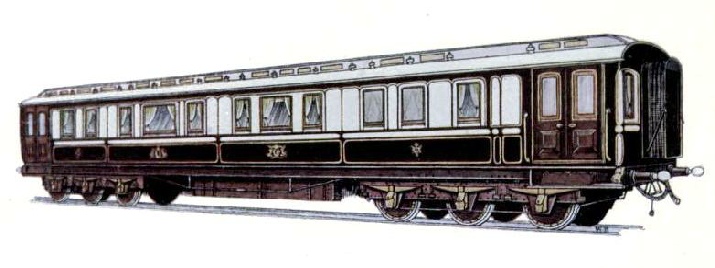
CAR USED BY HIS MAJESTY THE KING, LONDON & NORTH WESTERN RAILWAY.
In March 1875 sleeping saloons began to run between Euston and Holyhead. “The provision of this night facility”, says G. P. Neele, “made, I fancy, a considerable inroad into the little perquisites that had been recognised, the illegitimate earnings of the mail guards for the provision of the two sticks which it had been their custom to furnish to their likely patrons by means of these sticks and a spare cushion the space in the compartment was comfortably bridged over and a long, sofa-shaped seat established; indeed, these two sticks were quite a portion of the officer’s travelling stock”. Similar night saloons were put on between Euston and Liverpool on the 1st of April; and in July, to attract American travellers, day saloons were run by the midday train; but it was not until 1882 that twin saloons appeared on the line.
When railways came into existence the porters were allowed to keep bookstalls as a sort of perquisite, and very curious literature some of them provided. It was on the North Western that the reform began. In 1851, W. H. Smith & Son secured their first contract for the line, and by his care in the selection of literature, to which no exception could be taken, young W. H. Smith, afterwards First Lord of the Admiralty, obtained the nickname of “the North Western Missionary”. Within eleven years Smith’s bookstalls were on every line of importance in England, and he it was who started the placarding of the station walls with advertisements, for which some of us are not so grateful. Like most things, this bookstall idea was but the development of the existing, for the elder Smith had outrun the post, by which all newspapers used to be sent, by despatching them by the fast morning coaches instead of the night mail. To catch the coaches with the papers that came out late he started the red carts with horses good enough to pursue the coaches and overtake them if necessary; and sometimes, with quick changes, when the news was important, the carts went all the way. From the coaches the step was easy to the railways, and from sending them down the road the next step was to take the place of the porters’ stalls and sell them at stations on the way. Next to forwarding them by fast train came the sending them by special trains, and this led on to the newspaper trains. From selling books the step was easy to lending them, and thus came about the railway circulating library.
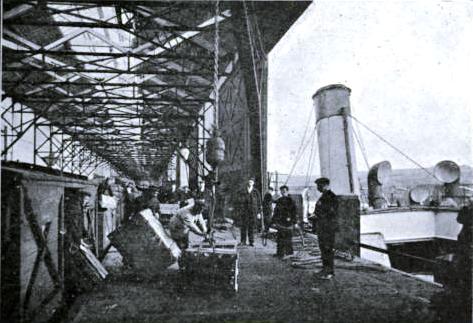
LOADING A NORTH WESTERN STEAMER AT HOLYHEAD.
It was Smith’s express that took the news of the death of George the Fourth to Dublin before the Government messenger. In those days the Dublin boats ran from Liverpool, where the North Western is now so much in evidence with its American specials to Riverside Station and other facilities for the transatlantic trade. The service from Holyhead has been competitive from the first, for the Government authorised the City of Dublin Steamship Company to supply the mail steamers from there, while at the same time the Chester & Holyhead Railway Company had obtained parliamentary permission to work steamboats; and both lines ran to Kingstown. For years, while the Irish mail was the fastest train out of Euston, the engines had to be changed at Holyhead owing to the Admiralty Pier being too weak to carry the express engine’s weight. It was for the convenience of passengers by the Irish trains that in March 1876 luncheon baskets were invented, the first station at which they could be obtained being Chester; and it was for the same trains that in 1880 Mr. Webb introduced his acetate of soda foot warmers that led to so many railway friendships owing to the conversation provoked by the porters tumbling them about and shaking them up when they cooled down - the ice of convention broken by a footwarmer being yet another instance of the influence of the trivial.
It was not until 1873, the year the North Western boats first went to Greenore, that the Irish service became fixed instead of tidal, and since then matters have so much developed that we have the American liners putting their passengers ashore at Holyhead instead of Liverpool; and Holyhead is only two miles farther from Euston than Fishguard is from Paddington.
Nowadays the North Western has a fleet of seventeen steamers, the newest being the Rathmore, on the service to Greenore, and the four sisters going to Dublin, named after the old boats of the Chester & Holyhead, Scotia, Anglia, Cambria, and Hibernia, that travel at 22 knots and are among the best afloat.
For whatever is done by the North Western is well done, not excepting the hotels, of which there are eight - those at Euston, Bletchley, Crewe, Birmingham, Liverpool, Holyhead, Dublin, and Greenore.
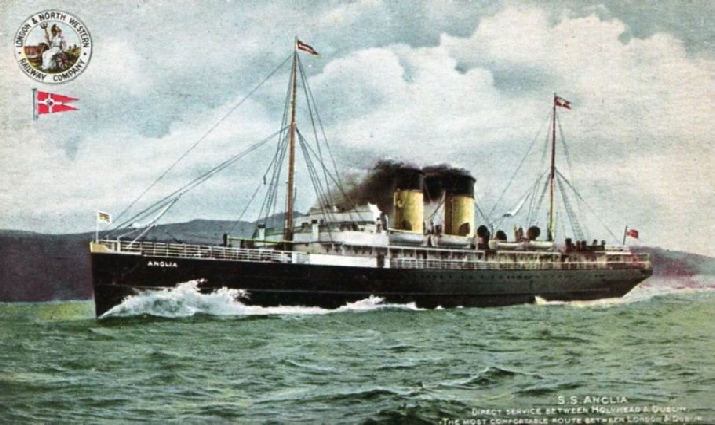
THE SS ANGLIA LEAVING HOLYHEAD FOR DUBLIN.
You can read more on , “The Caledonian Railway”, “The Story of the LMS” and “The World’s Most Famous Railway” on this website.


















 Meanwhile the machinery is being put together below. The pistons and their rods are being set in the cylinders with their rings and packing. The crossheads have to go on, and the slide-
Meanwhile the machinery is being put together below. The pistons and their rods are being set in the cylinders with their rings and packing. The crossheads have to go on, and the slide-





